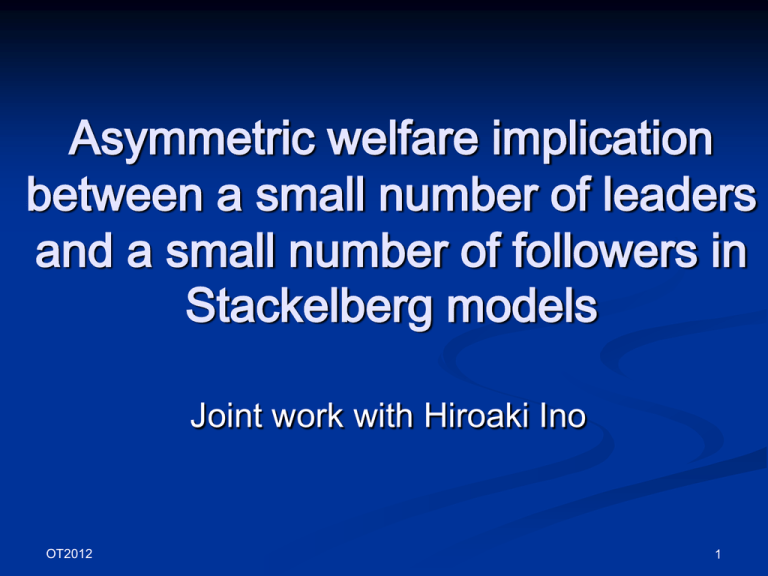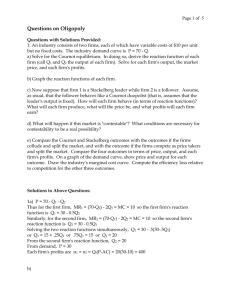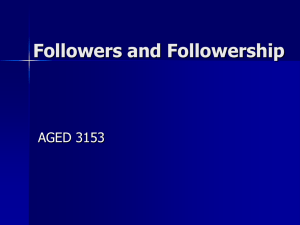The Model
advertisement

Asymmetric welfare implication between a small number of leaders and a small number of followers in Stackelberg models Joint work with Hiroaki Ino OT2012 1 Asymmetric welfare implication between small number of leaders and followers in Stackelberg models, with Hiroaki Ino (1) What role should public enterprises play in freeentry markets? (2010, JoE) (2) How many firms should be leaders? Beneficial concentration revisited (forthcoming in IER) 2012/3/4 2 Plan of the presentation (1) Rough sketch of the model and results (2) Motivation (3) Overview of related works (4) Formal explanation of our model (5) Results and implications OT2012 3 Rough sketch of the model m leaders, n followers, quantity-setting competition (1) m+n=N is given exogenously (2) m is given exogenously and n is determined by free entries. Our main concerns: Relationship between m and welfare (consumer surplus plus profits of all firms). OT2012 4 HHI (Herfindahl-Hirschman Index ) HHI =∑i=1n(firm i's market share)2 Higher HHI→Higher market concentration (1) An increase in the number of the firms decreases HHI (2) An increase in the asymmetries among the firms increases HHI Is an increase of asymmetries among the firms harmful or beneficial for welfare? OT2012 5 Fixed number of the firms In the first stage m leaders choose their output independently After observing the leaders' output, N-m followers choose their output independently. m=0 or m=N→ Cournot model m=1 standard Stackelberg model m=2,3,...,N-1 multiple leadership ~ a variant of Stackelberg model Stackelberg models yield higher HHI than the Cournot model OT2012 6 Results (fixed number of the firms) (1) Suppose that marginal cost is constant. W(m) > W(0) for 0 <m <N (beneficial concentration). (2) W'(m) <0 if m is sufficiently close to N. (3) W'(m) can be either positive or negative when m is close to 0. →It is possible that W(m) <W(0). (4) Suppose that the demand is linear and cost is quadratic. Then, for sufficiently large N, (a) W'(0) <0; (b) integer problem on the number of firms does not matter. OT2012 7 (1) m+n=N is given exogenously constant marginal cost W Stackelberg yields larger welfare →beneficial concentration Welfare at Cournot Equilibrium OT2012 N m 8 (1) m+n=N is given exogenously increasing marginal cost W N m Welfare at Cournot Equilibrium OT2012 9 Results (free entries of followers) W(m) > W(0) for 0 <m as long as the number of followers is positive. →beneficial concentration always takes place. ⇒HHI is a less plausible welfare measure at free entry markets than at the markets with significant entry barriers. Leadership is more likely beneficial in the long run. OT2012 10 Motivation Matsumura and Kanda (2005, JoE) Ino and Matsumura (2010, JoE) Ino and Matsumura (forthcoming, IER) This paper OT2012 11 Mixed Oligopoly at Free Entry Markets (JoE, 2005) Fixed number of private firms welfare-maximizing behavior of the public firm is never optimal. Free entry welfare-maximizing behavior of the public firm is always optimal. The public firm with deficits should be abolished rather than privatized. OT2012 12 What role should public enterprises play in free-entry markets? Fixed number of private firms The public firm should be a Stackelberg leader Free entry The public firm should not be a Stackelberg leader The same principle must be able to apply to pure oligopoly (although the result is completely different) → Matsumura and Ino (IER) OT2012 13 Benchmark:Fixed number of the firms W 0 OT2012 N m 14 Daughety (1990, AER) W 0 N OT2012 m 15 Lahiri and Ono (1988, EJ ) Welfare-improving production substitution ・An increase of the output of the firm with lower marginal cost + A decrease of the output of the firm with higher marginal cost →It economizes total production cost and improves welfare OT2012 16 Welfare-improving production substitution reaction curve of firm 1 X2 reaction curve of firm 2 reaction curve of firm 1 0 OT2012 X1 17 Welfare-reducing production substitution reaction curve of firm 1 X2 reaction curve of firm 2 reaction curve of firm 2 0 OT2012 X1 18 Notations N: Number of total firms m: Number of leaders xi: Firm i's output, X: Total output Ci(xi) : Firm i's production cost P(X): demand function πi: Firm i's profit CS: Consumer surplus, W: social surplus subscript L(F,C):Leader(Follower, Cournot) OT2012 19 The Model (fixed number of the firms) Players: identical m (∈[0,N]) leaders, identical N-m followers. Payoff: Its own profits First, leaders choose their output independently. After observing the leaders' outputs followers choose their outputs. The market opens at the end of the game. OT2012 20 Assumptions Assumption 1 P(X) is twice differentiable and P'(X)<0 for all X such that P(X)>0. Assumption 2 C(x) is twice differentiable and C'(x)>0, C''(x) ≧ 0 for all x ≧ 0.~a weaker assumption is presented in the paper presented today. Assumption 3 (strategic substitutes) P''(X)x+P'(X)<0 for all X such that P(X)>0 and x ∈ (0,X). Assumption 4 The model has the unique equilibrium for all m ∈ [0,N] and N >0. The equilibrium is symmetric and all firms produce positive outputs. OT2012 21 Proposition 1 Suppose that Assumptions 1-4 are satisfied. If C''(x)=0 for all x ≧ 0, then W*(m) > W*(0) for all m ∈ (0,N). If marginal cost is constant, beneficial concentration always takes place. →This is because Stackelberg model yields larger total output than the Cournot. (generalization of Daughety (1990) for general demand) OT2012 22 Proposition 2 Suppose that Assumptions 1-4 are satisfied. Then, (i) W*'(m) at m=0 can be either negative or positive and (ii) W*'(m) at m=N is always negative. (i) Introducing small number of leaders into the Cournot model can be either beneficial or harmful for welfare. (ii) Introducing small number of followers into the Cournot model is always beneficial for welfare. OT2012 23 Proposition 3 Suppose that P=a-X and C(x) =cx+kx2. If k>0, there exists N' >0 such that W'(m) at m=0 is negative for all N > N'. For any quadratic cost functions, there are cases where leadership is harmful. Leadership becomes harmful morel likely when the number of follower is large. OT2012 24 Why can introducing a small number of leaders into the Cournot model be harmful ? Consider the Stackelberg model with one leader (firm 1). Then firm 1 becomes a followers (Cournot). →Production substitutions from firm 1 to the other firms. This production substitution improves production efficiency when marginal cost is increasing and can dominate the positive effect of increasing CS. ~ This welfare-improving production substitution effect is strong when the number of followers is large. OT2012 25 Why is introducing a small number of followers into the Cournot model always beneficial? Consider the Stackelberg model with one follower (firm n). Then firm 1 becomes a leaders (Cournot). →Production substitutions from firm 1, 2..,N-1 to firm N. This production substitution improves production efficiency when marginal cost is increasing, but this effect is negligible because limm→N xL= limm→N xF= xC (Cournot output). ~When the number of followers is small, the difference of output level between each leader and follower is negligible. OT2012 26 Why convex? W 0 OT2012 N m 27 Why convex ? Consider the Stackelberg model with m leaders. Then firm m+1 becomes a leader. →Production substitutions from firm m+2, firm m+3,... firm N (firm 1, firm 2,..., firm m) to firm m+1. This production substitution worsens (improves) production efficiency. The former (latter) effect is weaker (stronger) when m is large. ~ An increase of the number of the leaders more likely improve welfare when m is large. OT2012 28 The Models (endogenous number of the followers) Players: identical m (∈[0,N]) leaders, potential new entrants (followers) Payoff: Its own profits OT2012 29 Why free entries of followers rather than the leaders ? Leader's profit is larger than follower's. If we consider free entry of leaders, no follower enter the market; resulting in the Cournot model. OT2012 30 The Model 1 (weakly persistentleadership model) Leaders have already enters the market. First, followers choose whether or not to enter the market. After observing the number of follower, all firms plays the same game described in the previous sections. OT2012 31 The Model 2 (strongly persistentleadership model) Leaders have already enters the market. First, leaders choose their outputs. After observing the leaders' outputs followers choose whether or not to enter the market. After observing the number of follower, followers choose their outputs. The market opens at the end of the game. OT2012 32 Propositions 4 and 5 Suppose that the number of followers entering the market is positive. Suppose that Assumptions 1-5 are satisfied. Then W**(m)>WC** for all m>0. (Assumption 5: Increasing marginal cost and positive entry cost) The Stackelberg model always yields higher welfare than the Cournot under free entry. Beneficial concentration always takes place. OT2012 33 Production substitution under free entries (model 1) Consider the Cournot model. Then firm 1 becomes a leader. →Leadership by firm 1 reduces the number of entering followers → Production substitutions from potential entrants to firm 1 takes place. Important point: the output of each follower entering the market does not change. Only the number of entering the firms is reduced. OT2012 34 Leadership is introduced P Follower's residual demand Follower's AC 0 Follower's output In the long run~reduction of followers OT2012 Y 35 Why is the leadership always beneficial under free entries? →Leadership by firm 1 reduces the number of entering followers → Production substitutions from potential entrants to firm 1 takes place. This saves follower's production costs at average cost base and increases the leader's production cost at marginal cost base. Since follower's average cost =P ≧ leader's marginal cost, this production substitution improves production efficiency ~ improves welfare OT2012 36










